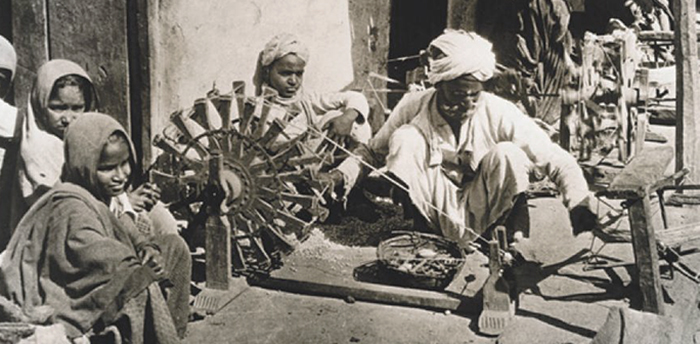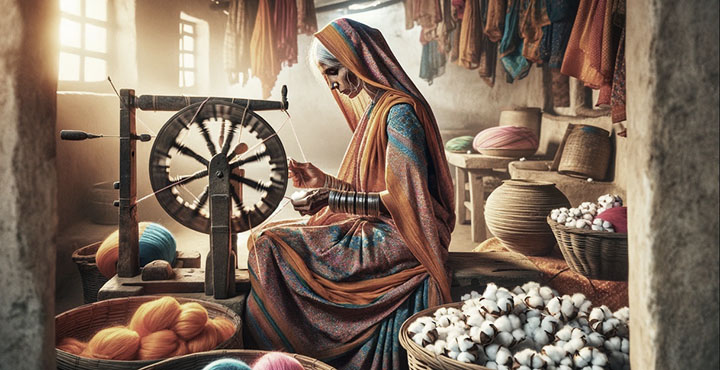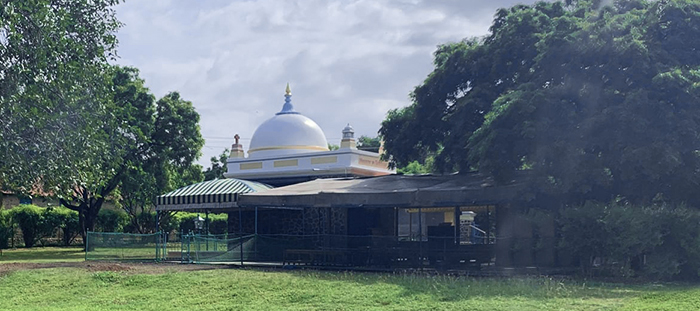INDIA'S COTTON KHADI

--------------------------------------
--------------------------------------
home grown, spun, woven |
Hand spun cloths have defined India’s fabrics for centuries. Indigenous production gained prominence among freedom fighters and Cotton Khadi became a symbol of liberty. Khadi is made by hand, in homes in villages, using a cotton yarn spun on a wheel. Khadi was advocated by Mahatma Gandhi to bind a vast nation together. Gandhi created khadi institutions to encourage spinning and weaving. Modi has promoted Khadi revival. Gandhiji Quotes: “I believe that where there is pure and active love for the poor there is god also. I see god in every thread I draw on the spinning wheel. The spinning wheel represents to me the hope of the masses”. From 3000 BC until the 1750’s, only the indigenous arboreum and herbaceum plants were used to grow cotton in India, known as old world cotton. Farmers and weavers worked together to create rich, organic woven textiles with a soft but durable texture. Creating textiles from local, old world cotton is part of a vibrant national legacy of making cloth from the first to last step on Indian soil INDIA CONTENTS : JOURNEYS, FABRICS: SUPERSTRUCTURE -------------------------------------
cotton khadi products
In 400 BC, the Greek historian Herodotus wrote that in India, there were “trees growing wild long furry like things, which produce a kind of wool better than sheep’s wool in splendor and quality. The Indians use this tree wool to make their clothes.” Khadi products are made using pure cotton, which is suitable for all types of weather. The hand weaving method interlaces the thread in such a way, that the fiber absorbs a maximum amount of air and comforts the body like no other fabric. Khadi products make the wearer feel comfortable and cool. When it's time to harvest, farmers will carefully pick it by hand. They'll use the money to support their families and their children's education. ---------------------------------- August 15, 1947, marked a turning point for the handloom weavers of India. The use of charkha by Mahatma Gandhi was a symbol of national regeneration and the subsequent focus on the weavers during the freedom movement was largely responsible for the breakthrough. With a view to raising funds for the industry and organising weavers – cooperatives, Parliament passed the Khadi and other Handloom Industries Development Act in 1953. -------------------------------------- --------------------------------------- Khadi is now being used by fashion houses around the world. Khadi sales have grown by 30% in the last 4 years, thanks to the Modi lead government, which is now encouraging Khadi at all levels. Belgaum Nestled high in the Western Ghats. Elevation 2,500 ft. Belgaum (or Belagavi) is a city in Karnataka. Belgaum was founded in the 12th century. The old town area with cotton and silk weavers stands besides the modern, bustling, tree-lined British Cantonment. In 1818 Belgaum was handed over to the British East India Company. The British had a sizable infantry post, until 1947 and India's Independence. There are presently an Indian Military post, 3 Universities and 10 Engineering and Technology colleges in Belgaum municipality. Belgaum Airport is located at Sambra and is connected by domestic flights. There are direct flights from Mumbai. Belgaum has many hotels. The Fern Belagavi, Marriott Belagavi etc. Khadi industries in Belgaum provide job opportunities to many traditional weavers and help in creating new designs. Women artisans play the main role in cotton production in Belgaum. Suresh Desai is a founding member of an Organic Farmers Club in Belgaum District. It has 400 members, some of whom are already growing food crops organically, while others are in the process of shifting to organic farming. It takes three years for a conventional cotton field to become fully organic. Shivaji Belgaum is 84% Hindu. 'Shiv Jayanti' is celebrated with great fervor, and Belagavi is known for its unique traditions and celebrations of Chhatrapati Shivaji Maharaj, Maharashtra's greatest warrior king (1630-1680). He once marched through Belgaum with his army. The rebellious local king attacked the army and was killed. 1657. His queen took up arms and attacked Shivaji but became captive. Shivaji forgave her, she then became a devotee of Shivaji and now there are many statues of Shivaji in Belgaum.
Organic cotton Organic cotton fields are healthy, non-GMO, grown by family-run cooperatives. No pesticides or chemicals — just water, organic compost, and warm sunshine. Organic cotton uses 92% less water than conventional cotton, and uses no synthetic pesticides or fertilisers. The production of 'organic cotton' in India is 51 per cent of global 'organic cotton' production. Farmers who truly grow organic cotton production say that organic textiles is a low-volume business and there is not much demand because of high prices. BCI cotton is a compromise between organic and standard pesticide intense cotton fields and BCI guidelines protect workers. Why seek out organic cotton? Non organic cotton (100% cotton labels) can be the world's dirtiest crop due to its heavy use of pesticides. But the problems with conventional cotton don't stop at the field. The cotton is trucked into a factory, treated with harsh petroleum-based chemicals, and coated with silicone waxes, ammonia and formaldehyde, and dipped in toxic solutions to make sure it's flame and soil retardant. Local farmers pasture their goats in cotton fields, after the cotton is picked. The plants, which have been sprayed with the many chemicals, kill the goats. Dificulties of farming organic cotton: Shortage of organic seeds. Lower yields per acre. The competition for selling at a reasonable price. It takes 3 years to convert a field into organic. Many competitors sell non organic cotton as organic and can therefor sell at a lower price. The middlemen make much of the profit. The certification system of organic cotton is rife with fake certificates. There are many farmers who genuinely grow organic, it is worth the trouble to find them. Crispin Argento, founder and managing director of the Sourcery, a small consulting firm that helps brands source organic cotton, has spent the past year hunting down organic cotton with his team, only to see suppliers disappear when asked for proof of authenticity. The idea of forming an organic farmer’s collective struck one farmer and it gradually grew to include around 30 farmers from nearby villages. The State Government approached them to help convert pesticide farms into organic ones. As of today, they have two projects which are underway at Naganur and Hukkeri.” In the case of the organic farmer’s collective, they have eliminated the middlemen from sourcing and selling. The products are available at Javik Society, Lalbagh and Organic Junction, Malleshwaram in Bengaluru (Bangalore). Arun Ambatipudi, executive director of Chetna Organic, one of a few nonprofits that provides training and support to organic cotton farmers in India, a growing demand, supply that’s in decline, ------------------------------- The European Union voted to no longer accept organic certifications on Indian raw products from the main companies responsible for organic cotton. Estimates that between one half and four-fifths of what is being sold as organic cotton from India is not genuine. In 2009, India’s agricultural export agency discovered wide-scale fraud in the country’s cotton belt, with entire villages certifying genetically modified cotton as organic. The paper-based certification scheme; “It led to a lot of cheating.” INDIA CONTENTS : JOURNEYS, FABRICS: SUPERSTRUCTURE
India cotton production
Hundreds of sugar cane growers have switched to cotton from sugar cane because of the higher returns. Cotton farming helps improve the fertility of the soil. Surat: 'Old Bombay Market' is known for its textile collection and is also known as the best Surat wholesale market, it is a must-see place for anyone looking for high-quality textile clothing. Maharashtra is the second leading producer of cotton in the country. Cotton is grown in Maharashtra, as it grows well in well-drained clayey soil and because of black soil there. Excellent climatic conditions exist in Maharashtra. Villages that are renowned for producing cotton Khadi include:
THE FOOD BASKET OF RAJASTHAN Ganganagar is the most important cotton-producing district of Rajasthan and accounts for over 80 per cent of the state's production. Sri Ganganagar is famed for its produce of wheat, mustard, cotton, bajra, sugarcane and grams. Kinnow, a hybrid citrus fruit is a popular horticultural product grown here. ----------------------------- Cotton Cotton. A long unicellular seed fibre grown on the outer skin of the cotton seed. Cotton is the only fabric in which no two fibers are identical. Belongs to the mallow family as do hibiscus and okra. Fibers vary from 10mm to 55mm in length, wild varieties, gossypium thurberi, are brown in color and cultivated hybrid types are white. The length of cotton fibre, known as staple length, is classified in three main groups:
One clear impact of Bt-cotton on Indian agriculture appears to be the replacement of areas of India, with Bt-hybrids, since the technology is available in India only in the form of hybrids. Large scale cultivation of Bt cotton hybrids may lead to the development of resistance to Bt toxins. To avoid the development of resistance, the use of non-Bt crop has been recommended but handly followed. India has had an effective ban on other GM seeds for some time. *** The Food Safety and Standards Authority of India (FSSA) Does not allow GM foods in India.!! BCI cotton Better Cotton Initiative (BCI), is a concept to grow cotton with judicious use of water, chemical fertilizers and pesticides, to reduce the environmental footprint of cotton farming. Better Cotton standards bringing together cotton's complex supply chain, from the farmers to the retailers. BCI cotton promotes better working conditions than standard cotton production. The BCI initiative develops and promotes good farm practices that allow more cotton to be grown while using less water and chemicals and protecting both working conditions and biodiversity. BCI cotton, has resulted in farmers switching from growing organic cotton to genetically modified, non-organic cotton. BCI Cotton is not organic. BCI tolerates the use of pesticides and genetically modified seeds. Sadly, the rapid growth of the Better Cotton Initiative is driving down sustainability standards in the cotton industry. Organic cotton or even BCI cotton is always better than just 100% cotton ------------------------------------- INDIA - SILKS ------------------------------------- WOOLS - EMBROIDERY ----------------------------------- INDIA - CHIKAN - LINEN ------------------------------------- article and website composed by elenagh@live.com
Avatar Meher Baba Samadhi - Tomb Shrine. Meherabad The Samadhi can be visited directly from either Pune or Ahmednagar. You need to hire a car with a driver who knows how to drive to the parking up the hill, near the Samadhi. Open to everyone from 7 am to 7 pm. Information about Meher Baba: https://avatarmeherbabatrust.org/ |
| Avatar in India Index | ||||
VISIT INDIA --------------------------- |
VISIT INDIA ---------------------------- |
VISIT INDIA --------------------------- |
||
| • HIMALAYAN VALLEYS | ||||
|




